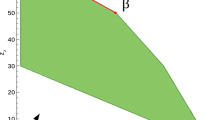Abstract
In Stolyar (Queueing Systems 50 (2005) 401–457) a dynamic control strategy, called greedy primal-dual (GPD) algorithm, was introduced for the problem of maximizing queueing network utility subject to stability of the queues, and was proved to be (asymptotically) optimal. (The network utility is a concave function of the average rates at which the network generates several “commodities.”) Underlying the control problem of Stolyar (Queueing Systems 50 (2005) 401–457) is a convex optimization problem subject to a set of linear constraints.
In this paper we introduce a generalized GPD algorithm, which applies to the network control problem with additional convex (possibly non-linear) constraints on the average commodity rates. The underlying optimization problem in this case is a convex problem subject to convex constraints. We prove asymptotic optimality of the generalized GPD algorithm. We illustrate key features and applications of the algorithm on simple examples.
Similar content being viewed by others
References
M. Andrews, K. Kumaran, K. Ramanan, A.L. Stolyar, R. Vijayakumar, and P. Whiting, Providing quality of service over a shared wireless link. IEEE Communications Magazine 39(2) (2001) 150–154.
K.J. Arrow, L. Hurwicz, and H. Uzawa (eds.), Studies in Linear and Non-Linear Programming (Stanford University Press, 1958), Chapters 6–8.
D.P. Bertsekas, Constrained Optimization and Lagrange Multiplier Methods (Academic Press, 1982).
P. Bender, P. Black, M. Grob, R. Padovani, N. Sindhushayana, and A. Viterbi, CDMA/HDR: A bandwidth efficient high speed wireless data service for nomadic users. IEEE Communications Magazine (July 2000).
D. Boyd and L. Vandenberghe, Convex Optimization (Cambridge University Press, 2004).
S.N. Ethier and T.G. Kurtz, Markov Process: Characterization and Convergence (John Wiley and Sons, New York, 1986).
A. Eryilmaz and R. Srikant, Fair resource allocation in wireless networks using queue-length-based scheduling and congestion control. In Proceeding of INFOCOM’2005, Miami (March 13–17 2005).
F.P. Kelly, A.K. Maullo, and D.K.H. Tan, Rate control in communication networks: Shadow prices, proportional fairness and stability. Journal of the Operational Research Society 49 (1998) 237–252.
F.P. Kelly, Fairness and stability of end-to-end congestion control. European Journal of Control 9 (2003) 159–176.
X. Lin and N.B. Shroff, The impact of imperfect scheduling on cross-layer rate control in wireless networks. In Proceeding of INFOCOM’2005, Miami (March 13–17 2005).
S. Low, A duality model of TCP and queue management algorithms. IEEE/ACM Transactions on Networking 11(4) (2003) 525–536.
M. Neely, E. Modiano, and C. Li, Fairness and optimal stochastic control for heterogeneous networks. In Proceeding of INFOCOM’2005, Miami (March 13–17 2005).
A. L. Stolyar, MaxWeight scheduling in a generalized switch: State space collapse and workload minimization in heavy traffic. Annals of Applied Probability 14(1) (2004) 1–53.
A.L. Stolyar, On the asymptotic optimality of the gradient scheduling algorithm for multi-user throughput allocation. Operations Research 53(1) (2005) 12–25.
A.L. Stolyar, Maximizing queueing network utility subject to stability: Greedy primal-dual algorithm. Queueing Syst. 50 (2005) 401–457.
P. Viswanath, D. Tse and R. Laroia, Opportunistic beamforming using dumb antennas. IEEE Transactions on Information Theory 48(6) (2002) 1277–1294.
Author information
Authors and Affiliations
Corresponding author
Additional information
AMS Subject Classifications: 90B15 · 90C25 · 60K25 · 68M12
Rights and permissions
About this article
Cite this article
Stolyar, A.L. Greedy primal-dual algorithm for dynamic resource allocation in complex networks. Queueing Syst 54, 203–220 (2006). https://doi.org/10.1007/s11134-006-0067-2
Received:
Revised:
Issue Date:
DOI: https://doi.org/10.1007/s11134-006-0067-2




